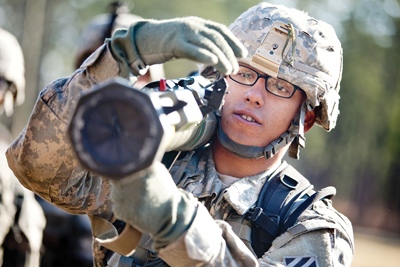EIB: New Master Skills Test Focuses on Weapons Proficiency

SGT Michael Lawson from the 2nd Battalion, 69th Armor Regiment trains on an M136 rocket launcher. (Photo by Ashley Cross)
Of the more than 500 Infantrymen who attempted to earn the Expert Infantryman Badge (EIB) at Fort Benning, Ga., in March, only 63 walked away with the badge after completing the rigorous, five-day test.
“It’s definitely tough, realistic training,” said MSG James Hill, NCOIC for the EIB testing. “They get placed in complex scenarios, which they may encounter when they’re deployed in an operational environment.”
Before beginning testing, the Infantrymen participated in a weeklong train-up. Veteran instructors showed them proper techniques for the various events they would be tested on, including day and night land navigation, first aid, patrol lane tasks, searching an individual, radio operation, traffic control lanes, and moving under direct fire. The test also includes a 12-mile foot march and the Army Physical Fitness Test. For the latter, candidates are held to a higher standard — they must achieve 75 points per event rather than the traditional 60 points.
New this year, a master skills test focusing on weapons proficiency precedes each of the three situational training exercise (STX) lanes. There are three weapon stations per lane for a total of nine different weapon systems.
“The Infantry School consistently adjusts our training in order to mirror the operational focus we might see when we deploy,” Hill said. “When I went for my Expert Infantryman Badge in 1996, it was basically 40 round-robin stations … and you were expected to execute the tasks without error. That holds true, but the basic setup is slightly different. The situational training exercise concept mirrors what an individual candidate will see in an operational environment.”
Candidates must succeed at each master skills test before proceeding down the STX lane. Candidates who cannot complete a task receive a “no-go” and are given one opportunity to try again before they’re out of the competition. Each candidate is allowed only two no-goes during the entire week of testing. Candidates who complete testing with all “goes” are recognized as “true blues.” Fourteen of the EIB recipients from the Benning test earned the true blue title.
“Attention to detail is what gets candidates through,” Hill said. “Each task has several sub-tasks, and if you miss one of those sub-tasks, you’ll get a no-go on that event.
“I received my EIB as a corporal. You’ll have PFCs that receive their EIB the first time and you’ll have sergeants first class that it takes three and four times. It’s really rank immaterial. It’s all about attention to detail and how well you are able to perform underneath intense pressure.” Some of that pressure comes from time limits. For example, the .50 caliber machine gun procedures have a 30-second time limit.
SFC Elijah Plante, NCOIC for the urban lane, said the candidates were motivated during the week of training — something they needed to hold onto for the real test.
“Everybody who’s here, they want their EIB, and they’re here for a reason,” he said. “We’re going to support them. We’re going to give them the best training they need and that we can provide. As long as they’re motivated, they pay attention and give it 100 percent, they will achieve their EIB this year.”
The 198th Infantry Brigade senior drill sergeant said the EIB was something every Infantryman should have. “It defines the men from the children,” he said. “It says that I am tactically proficient with all my tasks in my MOS. If you want to stand above your peers, you need to achieve it as soon as possible.”
According to the U.S. Army Infantry School’s EIB website, the “purpose of the EIB is to recognize Infantrymen who have demonstrated their mastery of critical tasks that build the core foundation of individual proficiency that allow them to locate, close with, and destroy the enemy through fire and maneuver and repel an enemy assault through fire and close combat.”
For more information on the EIB, testing standards, and other resources, visit http://www.benning.army.mil/infantry/EIB.
(This article was adapted from an article by Cheryl Rodewig, which was published in the 29 March 2013 issue of The Bayonet.)

 Share on Facebook
Share on Facebook email
email print
print